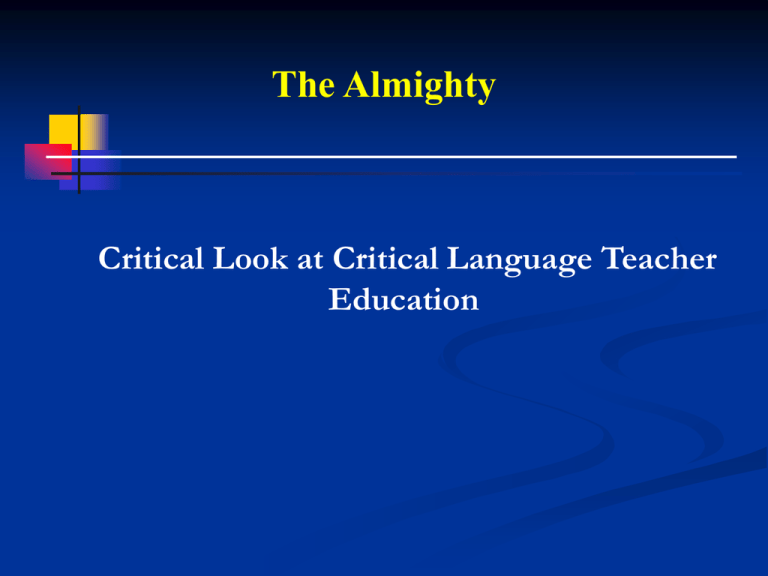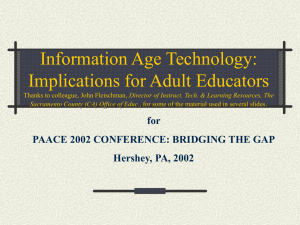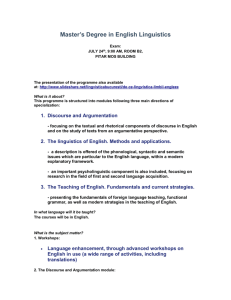Why critical language teacher education? The concept of
advertisement

The Almighty Critical Look at Critical Language Teacher Education An Overview Perhaps the most popular paradigms that challenge traditional views of language, teaching and learning are sociocultural and critical approaches (Lantolf, 2005, p.1 ). In this presentation, I provide a brief discussion of what critical mean in applied linguistics theory, and practice, in discourse analysis and what it means in language teacher education. Next, I talk about current pedagogies and practices in language teacher education across diverse contexts. Then, we will conclude with a Critical Look at Critical Language Teacher Education Defining Critical Critical Theory According to Habermas (1976, cited in Hawkins and Norton, 2009), critical theory challenges constructs such as naturalism, rationality, and neutrality and highlights instead the subjective, the social nature of reality Critical Pedagogy While critical theory is abstract, critical pedagogy is directly concerned with social action and educational change. Critical Discourse Analysis According to Fiarclough (1995), critical discourse analysis is a set of methodological tools that enables researchers to describe and analyze the relationship between language and social world (p. 224). Critical Applied Linguistics Pennycook (2001) offers the concept of critical applied linguistics arguing for the importance of relating micro relations of applied linguistics to macro relations of society. Why critical language teacher education? The concept of critical is especially salient for language teachers. Why? Because language, culture, and identity are integrally related and language teachers are central to address educational inequality, because of the particular learners they serve, many of whom are marginalized and because of the subject matter they teach- language and language can both empower and marginalize. Critical language teacher education practices McDonald and Zeichner (2008, cited in Hawkins & Norton) discuss the current move from multicultural education to social justice teacher education. Social justice teacher education seeks to address institutionalized as well as individual power differentials, with the goal of promoting teacher's recognition and ownership of their roles as social activities. These accounts can be categorized as critical awareness, critical selfreflection, and critical pedagogical relations. Critical Awareness A major focus of critical teacher educators is to promote critical awareness by raising consciousness about the ways in which power relations are constructed and function in society, and the extent to which historical, social, and political practices structure educational inequity. Critical Self-reflection Critical language teacher educators encourage teacher-learners to critically reflect on their own identities and positioning in society. Selfreflection provides a window on the relationship between the individual and the social world, highlighting both constrains on and possibilities for social change. Critical pedagogical relations If the goal of critical pedagogy is to empower learners, pedagogical relations between teacher educators and teacher-learners must be structured on equitable terms. Indeed, teacher educators should reflect on their attempts to restructure power relations between themselves and their teacherlearners. The post-method teacher educator The task of the postmethod teacher educator is to create conditions for prospective teachers to acquire necessary authority and autonomy that will enable them to reflect on and shape their own pedagogic experiences, and in certain cases transform such experiences. From a post-method perspective, teacher education is treated not as the experience and interpretation of a predetermined, prescribed pedagogic practice, but rather as an ongoing, dialogically constructed entity involving critically reflective participants. A critical look at critical teacher education From the critical teacher education, language teachers are not simply teaching language as a neutral vehicle for the expression of meanings and ideas, but are engaged both in reflecting upon the ideological forces that are present in their classrooms, schools, and communities and in empowering their learners with the language knowledge and skills they need to be able to function as moral agents in society. (Kumaravadivelu, 1999). Conclusion As Kumar (2006) remarks, since critical practice is situated, responsive and contextual, it is clear that the pursuit of a one-size-fits-all model of critical teacher education is inadequate. However, the absence of prescriptive models encourages the language teacher educator to reflect on the possibilities and limitations of any given context, and creatively seek enhanced opportunities for language learners through educational and social change. Thank You! Wish You All Good Luck and Success!











